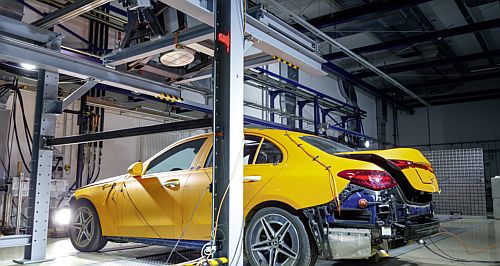Make / Model Search
News - Mercedes-BenzMercedes-Benz uses x-ray crash test technologyWorld-first use of x-ray camera technology aims to build even safer Mercedes-Benz models14 Mar 2024 By MATT BROGAN MERCEDES-BENZ is taking another leap forward in the assessment of its crash-test vehicles by installing a world-first x-ray camera system to deeply analyse a collision in extraordinary detail.
Developed in conjunction with the Fraunhofer-Institute for High-Speed Dynamics and the EMI (Ernst Mach Institute) in Freiburg, the system allows high-speed x-ray images to be filmed during the crash-test process, unveiling complex real-time information related to the vehicle’s crash performance, and the impact on the dummies inside.
The proof of concept shows how high-speed x-ray technology can be used to visualise highly dynamic internal deformation processes. Previously invisible deformations and their exact processes now become transparent; the numerous, high-resolution images allow precise analysis of the crash.
“The Mercedes-Benz x-ray crash sets a milestone in the development tools of the future,” explained Mercedes-Benz chief technology officer Markus Schafer.
“With a direct view into the hidden interior, it can help to draw important conclusions for the further improvement of vehicle safety. Mercedes-Benz thus confirms its role as a safety pioneer in automotive engineering.”
Mr Schafer said Mercedes-Benz has been developing the technology with its colleagues at the EMI for several years, the decisive breakthrough in the project coming from the use of a linear accelerator with 1kHz technology as the radiation source.
The device is far more powerful than the x-ray flashes previously used in trials: The photon energy of the linear accelerator is up to nine megaelectron volts. This allows all materials commonly used in vehicle construction to be screened.
The duration of the x-ray pulse is only a few microseconds. This makes it possible to record deformation processes in the crash test without motion blur. The linear accelerator also generates a continuous stream of these x-ray pulses.
This means that up to 1000 images per second are possible – or 1000 times more than with conventional x-ray procedures.
“The successful x-ray crash provides us with valuable insights to further optimise our technology for capturing previously inaccessible information,” said Fraunhofer EMI crash test centre head Dr Malte Kurfiss.
“Fraunhofer EMI is thus consistently pursuing its strategy of using high-speed x-ray imaging to make dynamic processes visible.”
During the crash test, the beams shine through the bodywork and any dummies from above. A flat detector is located under the test vehicle. It serves as a digital image receiver in the x-ray system: When the radiation hits the detector, an electrical signal is generated.
The intensity of this depends on how strongly the radiation was previously absorbed by the vehicle and dummy structure. This influences the grey value that is later visible – similar to the x-ray inspection of luggage at the airport or images of this kind taken by a doctor.
In the milliseconds of the actual impact time, the x-ray system shoots around 100 still images. Combined into a video, they provide highly exciting insights into what happens inside safety-relevant components and in the dummy's body during a crash. In this way, it is possible to observe in detail how the thorax of the dummy is pressed in or how a component is deformed.
The important part on the way from research to industrial application is the fact that the x-ray crash does not affect any other analysis tools. Even the interior cameras in the crash test vehicle record without any disturbance.
“The world's first x-ray crash shows that x-ray technology can provide revealing new insights,” said Mercedes-Benz director of vehicle safety Professor Dr Paul Dick.
“We learn what happens inside a vehicle and to the dummies during an accident. The x-ray images also offer the opportunity to further improve the model quality of the digital prototypes.”  Read more9th of August 2023  Mercedes-Benz considers V8 comeback: reportGerman report says Mercedes is considering reinstating V8 to C- and E-Class models26th of July 2023  ‘Benz reveals updated mid-size van rangeEQV, V-Class, V-Class Marco Polo, eVito and Vito score significant revisions for 20247th of July 2023  Mercedes-Benz unveils new CLE-ClassC- and E-Class models merge to form CLE, available as coupe and convertible in 2024 |
Click to shareMercedes-Benz articlesResearch Mercedes-Benz Motor industry news |











Facebook Twitter Instagram